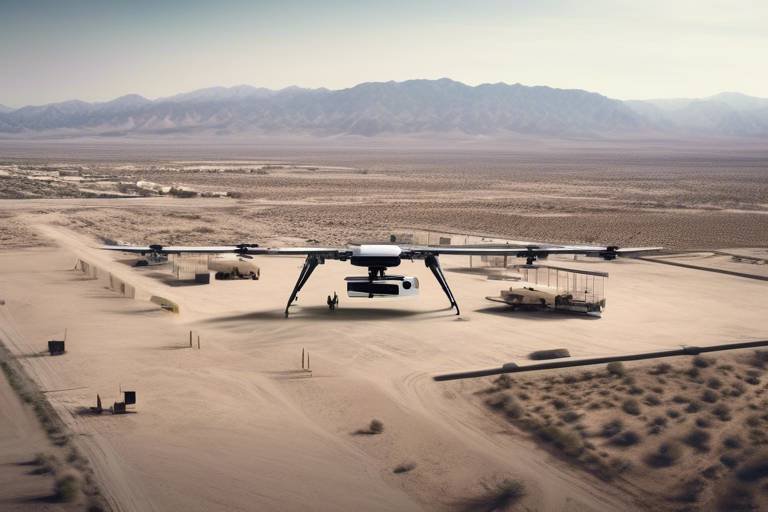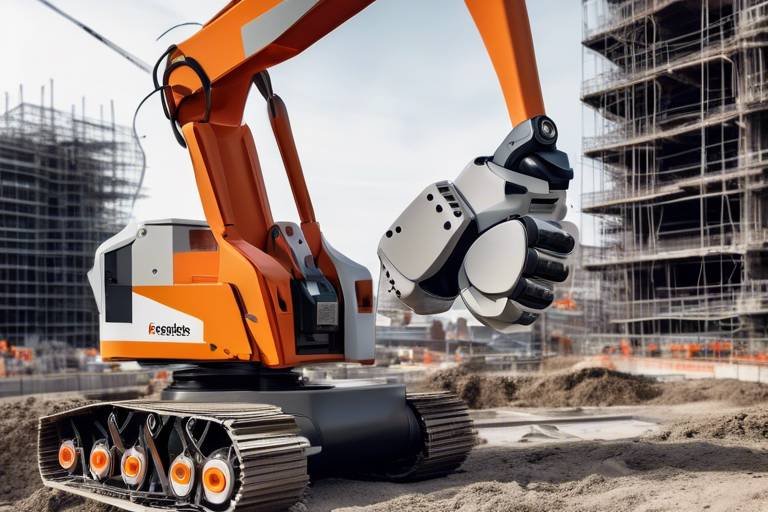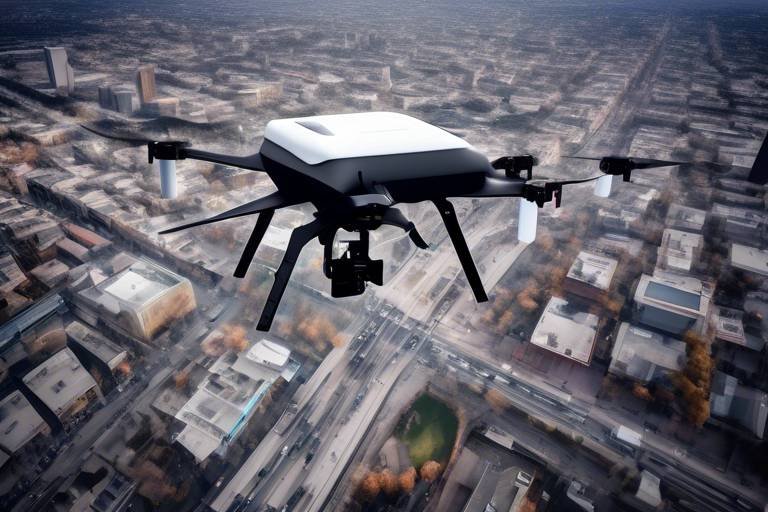How Autonomous Systems Are Supporting Sustainable Agricultural Practices
In recent years, the agricultural landscape has witnessed a remarkable transformation, largely thanks to the advent of autonomous systems. These technological marvels, which include drones, robotics, and advanced data analytics, are not just buzzwords; they are reshaping how we cultivate our crops and manage our resources. Imagine a farm where every decision is data-driven, where every action is optimized for efficiency, and where the environmental footprint is minimized. This is the promise of autonomous systems in agriculture, and it's a game changer for sustainability.
At the heart of this revolution is the need for sustainable practices that can meet the demands of a growing global population while conserving our precious resources. Autonomous systems provide farmers with the tools they need to achieve this delicate balance. By enhancing productivity and reducing waste, these technologies are paving the way for a more sustainable future in farming. But how exactly are they doing this?
First, let’s consider the efficiency that automation brings to the table. Traditional farming methods often involve guesswork and manual labor, which can lead to inefficiencies and resource wastage. However, with autonomous systems, farmers can utilize real-time data to make informed decisions about when to plant, irrigate, and harvest. This level of precision not only boosts crop yields but also conserves vital resources like water and fertilizers. For instance, precision agriculture technologies allow farmers to apply inputs only where and when they are needed, ensuring that nothing goes to waste.
Moreover, the integration of drones into agricultural practices has revolutionized crop monitoring. These flying robots can cover vast areas in a fraction of the time it would take a human, capturing high-resolution aerial imagery that reveals the health of crops and soil conditions. This capability enables farmers to identify potential issues—such as pest infestations or nutrient deficiencies—before they escalate, allowing for timely interventions that can save both crops and costs.
Another significant advancement is in robotic harvesting solutions. With the labor market facing shortages and rising costs, robotic systems are stepping in to perform tasks that were once solely in human hands. These robots can work tirelessly, picking crops at the optimal time for maximum yield, thereby ensuring that farmers don't miss out on their harvests. This not only increases efficiency but also aligns with sustainable practices by reducing the reliance on manual labor, which can be both costly and inconsistent.
As we look to the future, the potential for autonomous systems in agriculture is vast. With ongoing advancements in technology, we can expect even more innovative solutions that will support sustainable practices and enhance food security. However, it’s essential to address the challenges that accompany this shift. High initial costs, the need for technical expertise, and concerns over data privacy are hurdles that must be overcome to fully realize the benefits of these systems.
In conclusion, the integration of autonomous systems in agriculture represents a significant step towards a more sustainable future. By leveraging technology to optimize farming practices, we can ensure that we meet the needs of today without compromising the resources of tomorrow. The journey is just beginning, and as we embrace these innovations, the possibilities for sustainable agriculture are truly exciting.
- What are autonomous systems in agriculture? Autonomous systems in agriculture refer to technologies such as drones and robotics that automate farming tasks, enhancing efficiency and sustainability.
- How do drones benefit farmers? Drones provide aerial imagery for crop monitoring, allowing farmers to assess crop health, soil conditions, and identify pests, leading to better decision-making.
- What challenges do farmers face when adopting autonomous technologies? Farmers may encounter high initial costs, a need for technical skills, and concerns about data privacy and security when implementing these technologies.
- What is precision agriculture? Precision agriculture uses data analytics to optimize farming practices, ensuring that resources like water and fertilizers are used efficiently.
Introduction to Autonomous Systems in Agriculture
Autonomous systems are making waves in the agricultural sector, and it's not just a passing trend. These innovative technologies, including drones, robotics, and AI-driven machines, are fundamentally changing how we approach farming. Imagine a world where farmers can monitor their crops from the sky or have robots do the heavy lifting during harvest season. Sounds futuristic, right? But it’s happening now, and it’s transforming agriculture into a more sustainable and efficient practice.
At the heart of this transformation is the ability of autonomous systems to enhance efficiency while reducing resource consumption. Think about it: traditional farming methods often rely on manual labor and guesswork, leading to wasted resources and suboptimal yields. With autonomous systems, farmers can leverage technology to make data-driven decisions that promote sustainability. For instance, precision agriculture utilizes real-time data to optimize the use of water, fertilizers, and pesticides, minimizing waste and environmental impact.
Furthermore, these technologies are not just about saving resources; they also improve productivity. By automating routine tasks, farmers can focus on strategic planning and innovation. Imagine a farmer who can monitor crop health from a drone while sipping coffee in their kitchen. This shift allows for better management of crops, leading to healthier yields and a more sustainable farming environment.
However, the journey towards fully integrating autonomous systems in agriculture is not without its challenges. Issues such as high initial costs and the need for technical expertise can pose significant hurdles. Yet, the potential benefits far outweigh these challenges. As we delve deeper into the various aspects of autonomous systems in agriculture, we’ll uncover how they are not only improving farming practices but also paving the way for a more sustainable future.
Benefits of Automation in Farming
Automation in farming is not just a trend; it's a game changer! Imagine a world where farmers can focus on strategy and creativity rather than getting bogged down by repetitive tasks. That's precisely what automation brings to the table. By integrating advanced technologies like robotics and data analytics into agricultural practices, farmers can significantly enhance their operational efficiency. This shift not only reduces labor costs but also allows for a level of precision that manual farming simply cannot achieve.
One of the standout benefits of automation is the ability to monitor crop health in real-time. With tools like drones and sensors, farmers can gather vital data about their fields, allowing them to make informed decisions on the go. For instance, if a drone identifies a section of a field that’s suffering from drought stress, the farmer can act quickly to address the issue, ensuring that water resources are used efficiently. This proactive approach is akin to having a personal assistant who keeps an eye on everything, allowing you to focus on the bigger picture.
Moreover, automation fosters better resource management. By using precision agriculture technologies, farmers can apply inputs such as water, fertilizers, and pesticides more accurately. This means less waste and a smaller environmental footprint. For example, instead of blanket applying fertilizers across a field, farmers can use data-driven insights to apply them only where needed. This targeted approach not only saves money but also reduces the risk of runoff into nearby water bodies, which can be detrimental to local ecosystems.
To illustrate the impact of automation, consider the following table that outlines the major benefits:
| Benefit | Description |
|---|---|
| Reduced Labor Costs | Automation minimizes the need for manual labor, saving money on wages and increasing profitability. |
| Increased Precision | Technologies allow for more accurate application of inputs, which leads to better crop yields and less waste. |
| Real-Time Monitoring | Drones and sensors provide immediate data, enabling quick responses to crop health issues. |
| Resource Conservation | Efficient use of water, fertilizers, and pesticides helps in conserving natural resources and protecting the environment. |
In essence, the benefits of automation in farming create a ripple effect that goes beyond just the farm. They promote sustainability, enhance productivity, and ultimately contribute to food security. It's like planting a seed that grows into a robust tree, providing shade and fruit for generations to come. The future of agriculture is bright, and automation is at the heart of this transformation.
- What are the main technologies used in agricultural automation?
Common technologies include drones, robotic harvesters, and precision agriculture software that utilizes data analytics. - How does automation impact small farms?
While automation can be costly, it also offers small farms the opportunity to compete by improving efficiency and reducing labor costs. - Are there any downsides to automation in farming?
Yes, challenges include high initial costs, the need for technical skills, and concerns over data privacy.
Precision Agriculture Technologies
In the rapidly evolving world of agriculture, are becoming the backbone of modern farming practices. By leveraging data analytics and advanced technology, farmers can optimize field-level management, making their operations not only more efficient but also significantly more sustainable. Imagine being able to apply just the right amount of water, fertilizers, and pesticides at the exact moment they are needed. This not only minimizes waste but also reduces the environmental impact of farming.
At its core, precision agriculture involves the use of various tools and techniques that allow farmers to monitor and manage their crops with unparalleled accuracy. For instance, GPS technology plays a crucial role, allowing farmers to map their fields and track the performance of their crops in real-time. This data-driven approach enables them to identify which areas of their fields are thriving and which are struggling, leading to targeted interventions that can boost yields and reduce resource use.
Another exciting aspect of precision agriculture is the integration of IoT (Internet of Things) devices. These smart sensors can be placed throughout the fields to collect data on soil moisture, temperature, and nutrient levels. This information is invaluable as it allows farmers to make informed decisions, such as when to irrigate or fertilize, based on the specific needs of their crops. The result? A significant reduction in water and fertilizer usage, which is a win-win for both the farmer and the environment.
Moreover, data analytics plays a pivotal role in precision agriculture. By analyzing historical and real-time data, farmers can predict trends and make proactive decisions. For example, if data indicates that certain pests are likely to invade, farmers can take preventive measures before the problem escalates. This proactive approach not only saves crops but also limits the need for chemical interventions, promoting a healthier ecosystem.
To illustrate the impact of precision agriculture, consider the following table that summarizes some of the key technologies and their benefits:
| Technology | Benefits |
|---|---|
| GPS Technology | Enables precise mapping and monitoring of fields. |
| IoT Sensors | Collects real-time data on soil and crop conditions. |
| Data Analytics | Facilitates predictive analysis for better decision-making. |
| Drones | Provides aerial imagery for crop health assessment. |
In summary, precision agriculture technologies are not just about increasing productivity; they are about redefining the relationship between farming and the environment. With the ability to make data-driven decisions, farmers can significantly reduce their resource consumption while maximizing their yields. This innovative approach is paving the way for a more sustainable future in agriculture, ensuring that we can feed a growing population without compromising the health of our planet.
Use of Drones in Crop Monitoring
Drones have emerged as a game-changer in the realm of agriculture, particularly in the area of crop monitoring. Imagine being able to survey hundreds of acres of farmland in just a few hours, gaining insights that would traditionally take days or even weeks. This is the power of drones, and it's transforming how farmers manage their crops. By harnessing aerial imagery and advanced data collection capabilities, drones allow farmers to monitor crop health and assess soil conditions with unprecedented accuracy.
One of the most remarkable aspects of drone technology is its ability to provide real-time data. Farmers can fly drones over their fields to capture high-resolution images that reveal critical information about crop vitality. For instance, using multispectral cameras, drones can detect variations in plant health by analyzing light reflectance. This data can indicate whether crops are thriving or struggling due to factors like nutrient deficiencies or pest infestations.
Furthermore, the use of drones in crop monitoring enables farmers to make informed decisions based on precise data rather than guesswork. This leads to a more efficient allocation of resources, such as water and fertilizers, minimizing waste and environmental impact. For example, with drone technology, farmers can identify specific areas of a field that require additional irrigation or fertilization, ensuring that every drop of water and every granule of fertilizer is used effectively.
In addition to monitoring crop health, drones can also assist in identifying pest problems before they escalate. By pinpointing areas where pests are present, farmers can apply targeted treatments, reducing the need for widespread pesticide applications. This not only saves money but also contributes to a more sustainable approach to farming.
To illustrate the impact of drones on crop monitoring, consider the following table that highlights some key benefits:
| Benefit | Description |
|---|---|
| Real-Time Data | Drones provide immediate insights into crop health, allowing for quick decision-making. |
| Precision Agriculture | Farmers can apply inputs more efficiently, reducing waste and costs. |
| Pest Detection | Early identification of pest issues leads to targeted treatments, minimizing pesticide use. |
| Soil Assessment | Drones can evaluate soil conditions, helping farmers optimize their land management practices. |
In conclusion, the use of drones in crop monitoring is not just a technological trend; it's a vital tool for enhancing agricultural sustainability. By providing farmers with accurate, timely data, drones empower them to make better decisions, optimize resource use, and ultimately increase productivity. As this technology continues to evolve, we can expect even greater innovations that will further support sustainable agricultural practices.
Robotic Harvesting Solutions
In the fast-evolving world of agriculture, are becoming a game-changer, transforming how we think about and approach the harvest season. Imagine a field bustling with activity, but instead of farmers toiling under the sun, you see advanced machines gliding through rows of crops, expertly picking fruits and vegetables with precision and speed. These systems are not just futuristic dreams; they are a reality that is reshaping the farming landscape.
One of the most significant advantages of robotic harvesting is the efficiency it brings to the table. Traditional harvesting methods often rely on manual labor, which can be time-consuming and labor-intensive. In contrast, robotic harvesters can operate around the clock, significantly reducing the time required to gather crops. This means that farmers can reap their harvest at the optimal time, ensuring that the produce is picked at its peak quality, which is crucial for maximizing yield and profitability.
Moreover, robotic harvesters are equipped with sophisticated sensors and algorithms that allow them to identify the ripeness of crops. This level of precision minimizes waste, as only the best-quality produce is harvested, leaving behind underdeveloped or damaged items. For instance, a robotic harvester can distinguish between ripe tomatoes and those that are not ready for picking, ensuring that only the best reach the market. This capability not only boosts the quality of the harvest but also enhances the sustainability of farming practices by reducing the amount of waste generated.
Another exciting aspect of robotic harvesting solutions is their ability to adapt to different crops and field conditions. Whether it's delicate strawberries or robust corn, these machines can be programmed to handle various harvesting tasks. This versatility is crucial for farmers who grow multiple types of crops, as it allows them to streamline their operations without needing to invest in different harvesting equipment for each crop type.
However, the introduction of robotic harvesting does not come without its challenges. The initial investment for these technologies can be substantial, which may deter smaller farms from adopting them. Yet, as technology advances and becomes more affordable, we can expect to see wider adoption across the agricultural sector. In fact, many experts believe that the long-term savings in labor costs and increased efficiency will outweigh the initial financial barriers.
To further illustrate the impact of robotic harvesting solutions, consider the following table that summarizes their key benefits:
| Benefit | Description |
|---|---|
| Increased Efficiency | Robotic harvesters can operate continuously, reducing harvest time significantly. |
| Precision | Advanced sensors ensure only ripe crops are harvested, minimizing waste. |
| Versatility | Can adapt to various crops and field conditions, allowing for diverse farming. |
| Labor Cost Reduction | Less reliance on manual labor translates to lower long-term operational costs. |
In conclusion, as we look to the future, robotic harvesting solutions are set to play a pivotal role in sustainable agriculture. By enhancing efficiency, reducing waste, and allowing for precise harvesting, these technologies not only support farmers in maximizing their yield but also contribute to a more sustainable and environmentally friendly agricultural practice.
- What are robotic harvesting solutions? Robotic harvesting solutions are automated systems designed to harvest crops efficiently and precisely, reducing the need for manual labor.
- How do robotic harvesters improve efficiency? They can work continuously, operate in various field conditions, and use sensors to determine the ripeness of crops, which speeds up the harvesting process.
- Are robotic harvesters expensive? While the initial investment can be high, many believe that the long-term savings and increased efficiency will justify the cost.
- Can robotic harvesters be used for different types of crops? Yes, many robotic harvesters are versatile and can be programmed to handle a variety of crops.
Impact on Resource Conservation
Autonomous systems are not just about making farming easier; they play a pivotal role in resource conservation. By leveraging advanced technologies, these systems enable farmers to use their resources more wisely, which is essential in today's world where every drop of water and every grain of fertilizer counts. Imagine a farmer who can determine exactly how much water a crop needs at any given moment—this is the reality that autonomous systems bring to the table.
One of the most significant impacts of these technologies is seen in water management. Traditional irrigation methods often lead to overuse of water, resulting in wastage. However, with the advent of precision irrigation systems powered by autonomous technology, farmers can monitor soil moisture levels in real-time. This allows them to water their crops only when necessary, ensuring that every drop is utilized efficiently. According to recent studies, farms that have implemented such systems have seen a reduction in water usage by up to 30%.
Moreover, autonomous systems enhance the application of fertilizers and pesticides. Using drones equipped with sensors, farmers can analyze the nutrient requirements of different areas within a field. This targeted approach means that fertilizers can be applied only where needed, minimizing excess and reducing the risk of runoff that can harm local ecosystems. In fact, this method can reduce fertilizer usage by as much as 25%, leading to significant cost savings and a smaller environmental footprint.
To illustrate the impact of these technologies, consider the following table that summarizes the resource conservation benefits:
| Resource | Traditional Method Usage | With Autonomous Systems | Reduction |
|---|---|---|---|
| Water | 100% (excessive) | 70% | 30% |
| Fertilizers | 100% (excessive) | 75% | 25% |
| Pesticides | 100% (excessive) | 80% | 20% |
In addition to these direct benefits, autonomous systems also contribute to soil health. By optimizing the use of inputs, farmers can maintain healthier soil, which in turn supports better crop yields. Healthy soil is crucial for sustainable agriculture, as it fosters biodiversity and resilience against pests and diseases. Thus, the integration of autonomous systems not only conserves resources but also enhances the overall health of the farming ecosystem.
In conclusion, the impact of autonomous systems on resource conservation is profound. By optimizing water, fertilizers, and pesticides, these technologies pave the way for a more sustainable agricultural future. As farmers adopt these innovations, they are not just improving their productivity; they are also becoming stewards of the environment, ensuring that resources are available for future generations.
- What are autonomous systems in agriculture? Autonomous systems in agriculture refer to technologies like drones and robotics that operate independently to enhance farming efficiency and sustainability.
- How do autonomous systems conserve resources? They optimize the use of water, fertilizers, and pesticides by providing precise data and analytics, leading to reduced waste and environmental impact.
- What are the challenges of implementing these technologies? High initial costs, the need for technical expertise, and concerns over data privacy can hinder the adoption of autonomous systems in agriculture.
- What is the future of autonomous systems in agriculture? The future looks promising with ongoing advancements in technology that will further enhance capabilities and support sustainable practices.
Challenges in Implementing Autonomous Technologies
While the benefits of autonomous systems in agriculture are clear, the path to their widespread adoption is fraught with challenges. One of the most significant hurdles is the high initial costs associated with acquiring advanced technologies. For many small to medium-sized farms, investing in drones, robotics, and data analytics software can seem like a daunting financial commitment. In fact, many farmers may find themselves weighing the cost against their current operational budgets, leading to hesitation in embracing these innovative solutions.
Moreover, the need for technical expertise cannot be overstated. Farmers and agricultural workers must possess a certain level of technological proficiency to effectively operate and maintain these systems. This often necessitates additional training and education, which can be a barrier for those who have been accustomed to traditional farming methods. Imagine a seasoned farmer who has spent decades mastering the art of planting and harvesting now facing the challenge of navigating complex software or troubleshooting robotic machinery. It can be overwhelming!
Another pressing concern revolves around data privacy and security. With the integration of autonomous technologies comes the need to collect and analyze vast amounts of data. This data can include sensitive information about crop yields, soil health, and even financial records. Farmers may worry about who has access to this data and how it could potentially be used against them. The fear of data breaches or misuse can deter some from fully embracing the technological shift.
In addition to these challenges, there is also a cultural resistance to change within the agricultural community. Many farmers have deep-rooted traditions and practices that have been passed down through generations. The introduction of autonomous systems may be viewed with skepticism or apprehension, as some may believe that technology could undermine the human touch that is so vital to farming. This cultural aspect can slow the adoption rate, as farmers may prefer to stick with what they know rather than venture into uncharted territory.
To summarize, the challenges in implementing autonomous technologies in agriculture can be categorized as follows:
- High Initial Costs: The financial burden can be significant for smaller farms.
- Technical Skills Requirement: A skilled workforce is necessary for effective integration.
- Data Privacy and Security: Concerns about who controls and accesses sensitive data.
- Cultural Resistance: A reluctance to abandon traditional farming methods.
Despite these challenges, it is crucial for the agricultural sector to address these issues head-on. By investing in education and training, fostering a culture of innovation, and ensuring robust data protection measures, the industry can pave the way for a more sustainable and efficient future. The journey may be challenging, but the rewards of embracing autonomous technologies are well worth the effort.
Q1: What are the main benefits of autonomous systems in agriculture?
A1: Autonomous systems enhance efficiency, reduce labor costs, and allow for real-time monitoring of crop health, leading to better resource management.
Q2: How do drones contribute to sustainable farming?
A2: Drones provide aerial imagery and data collection, helping farmers assess crop health and soil conditions, which supports informed decision-making and reduces waste.
Q3: What are the economic barriers to adopting autonomous technologies?
A3: High initial costs for purchasing and implementing these technologies can be a significant barrier, particularly for small to medium-sized farms.
Q4: How can farmers overcome the technical skills requirement?
A4: Farmers can seek training programs and workshops that focus on technology and data analysis to develop the necessary skills for operating autonomous systems.
Q5: What measures can be taken to ensure data privacy in agriculture?
A5: Implementing strong data security protocols and educating farmers about data management can help alleviate concerns over privacy and data misuse.
Economic Barriers to Adoption
When it comes to adopting autonomous systems in agriculture, one of the most significant hurdles is the economic barrier. Many small and medium-sized farms often find themselves in a tight spot when it comes to financing these advanced technologies. The initial investment required for autonomous systems—such as drones, robotic harvesters, and precision agriculture tools—can be quite steep. This is especially challenging for farmers who are already operating on thin margins.
Consider this: a typical drone suitable for agricultural use can cost anywhere from $1,000 to $10,000, depending on its capabilities. And that’s just the tip of the iceberg! When you factor in the costs of training, software, maintenance, and potential upgrades, the total investment can easily escalate into the tens of thousands of dollars. For many farmers, this is simply not feasible.
Moreover, the financial landscape in agriculture is often unpredictable. Crop yields can fluctuate due to various factors, including weather conditions and market demand. This uncertainty makes farmers hesitant to invest heavily in new technologies. After all, why put money into a system that may not yield immediate returns?
To illustrate the economic barriers further, let’s take a look at a table that outlines some of the typical costs associated with implementing autonomous systems:
| Technology | Estimated Cost | Additional Expenses |
|---|---|---|
| Drones | $1,000 - $10,000 | Software, Training, Maintenance |
| Robotic Harvesters | $50,000 - $200,000 | Repairs, Upgrades |
| Precision Agriculture Tools | $5,000 - $25,000 | Data Analysis Services, Subscriptions |
In addition to the upfront costs, there’s also the challenge of access to financing. Traditional banks may be hesitant to lend money for such high-risk investments, particularly if the farmer's credit history is not robust. This creates a vicious cycle where farmers who need the technology the most are often the ones who cannot afford it.
Furthermore, the rapid pace of technological advancements can leave farmers feeling overwhelmed. Just when they think they've made a sound investment, new models and systems hit the market, making their current technology feel obsolete. This fear of falling behind can prevent farmers from making the leap to adopt these beneficial systems.
In summary, while autonomous systems have the potential to revolutionize agriculture, the economic barriers to their adoption are significant. Farmers must navigate a complex landscape of high costs, uncertain returns, and limited access to financing. Until these barriers are addressed, the full potential of autonomous farming may remain just out of reach for many.
- What are autonomous systems in agriculture? Autonomous systems refer to technologies like drones and robotic machinery that perform agricultural tasks without human intervention.
- Why are autonomous systems important for sustainability? They help reduce resource consumption and improve efficiency, which is crucial for sustainable farming practices.
- What are the main challenges in adopting these technologies? High costs, the need for technical expertise, and concerns about data privacy are the primary challenges faced by farmers.
- How can farmers overcome economic barriers? Exploring financing options, government subsidies, and cooperative purchasing can help mitigate some of the financial challenges.
Technical Skills Requirement
The integration of autonomous systems in agriculture is not just about having the latest gadgets; it’s about understanding how to use them effectively. As farms evolve into high-tech operations, the need for technical skills becomes increasingly critical. Farmers and agricultural workers must adapt to a world where traditional farming methods are complemented—or even replaced—by advanced technologies. This shift requires a workforce that is not only familiar with agricultural practices but also proficient in technology and data analysis.
Imagine a farmer who can not only plant seeds but also analyze data from drones hovering above their fields. This farmer needs to understand how to interpret the aerial imagery, assess the health of crops, and make data-driven decisions. The skills required extend beyond just operating a drone; they encompass a range of competencies, including:
- Data Analysis: The ability to analyze large sets of data to make informed decisions is crucial. Farmers must learn how to interpret data from sensors and drones to optimize their practices.
- Technical Proficiency: Familiarity with software programs that manage autonomous systems is essential. This includes understanding how to operate and troubleshoot drones and robotic systems.
- Understanding of Precision Agriculture: Knowledge of precision agriculture techniques helps farmers apply inputs more efficiently, minimizing waste and maximizing yield.
Moreover, the rapid pace of technological advancement means that continuous learning is vital. Workshops, online courses, and training programs are becoming essential for those in the agricultural sector. As a result, educational institutions and agricultural organizations are stepping up to provide resources aimed at enhancing technical skills in the farming community.
In conclusion, while the benefits of autonomous systems in agriculture are vast, the successful implementation of these technologies hinges on the workforce's ability to adapt. As we look towards a future where technology and agriculture are intertwined, investing in technical skills is not just beneficial; it’s necessary for sustainable growth and productivity in the farming sector.
Q1: What are autonomous systems in agriculture?
A1: Autonomous systems in agriculture refer to technologies such as drones, robotics, and sensors that operate with minimal human intervention to enhance farming efficiency and sustainability.
Q2: Why is technical skill development important in agriculture?
A2: As farming becomes more technology-driven, workers need technical skills to operate and manage these systems effectively, ensuring they can maximize productivity and sustainability.
Q3: How can farmers acquire the necessary technical skills?
A3: Farmers can acquire technical skills through training programs, workshops, online courses, and partnerships with educational institutions focused on agricultural technology.
Future of Autonomous Systems in Sustainable Agriculture
The future of autonomous systems in sustainable agriculture is not just bright; it's downright revolutionary! As technology continues to advance, we can expect these systems to become even more integrated into farming practices, enhancing productivity while minimizing environmental impact. Imagine a world where farmers can manage their fields with unparalleled precision, using data-driven insights to make real-time decisions that promote sustainability. This is not just a dream; it's on the horizon!
One of the most exciting prospects is the development of smart farming technologies that leverage artificial intelligence (AI) and machine learning. These technologies will allow autonomous systems to analyze vast amounts of data, leading to more informed decisions about crop management, irrigation, and pest control. For instance, AI can predict weather patterns and suggest optimal planting times, helping farmers maximize yields while conserving resources.
Furthermore, the integration of Internet of Things (IoT) devices will enable farmers to connect various autonomous systems, creating a cohesive network that monitors and manages agricultural operations. This interconnectedness will facilitate real-time data sharing and analysis, allowing farmers to respond swiftly to changing conditions. Imagine drones equipped with sensors that not only monitor crop health but also communicate with robotic harvesters to optimize the timing of harvests!
As we look towards the future, it's also essential to consider the role of sustainability in shaping these technologies. Companies are increasingly focusing on creating eco-friendly autonomous systems that reduce waste and lower carbon footprints. For example, precision irrigation systems can significantly decrease water usage by delivering the exact amount of moisture needed directly to the plant roots, minimizing evaporation and runoff.
However, the journey toward fully autonomous and sustainable agriculture won't be without its challenges. Farmers will need to navigate issues such as regulatory hurdles, the need for ongoing education, and the integration of new technologies into traditional practices. Yet, the potential rewards are immense. By embracing these innovations, farmers can not only enhance their productivity but also contribute to a more sustainable food system.
In conclusion, the future of autonomous systems in sustainable agriculture is filled with promise. As we continue to innovate and adapt, we can look forward to a farming landscape that is not only more efficient but also kinder to our planet. The synergy between technology and sustainability will undoubtedly pave the way for a new era in agriculture, where food security and environmental stewardship go hand in hand.
- What are autonomous systems in agriculture? Autonomous systems in agriculture refer to technologies such as drones, robots, and AI that operate independently to enhance farming practices.
- How do autonomous systems promote sustainability? They optimize resource use, reduce waste, and minimize the environmental impact of farming activities.
- What challenges do farmers face when adopting these technologies? Challenges include high initial costs, the need for technical expertise, and concerns over data privacy and security.
- What is the role of AI in autonomous farming? AI helps analyze data for better decision-making, predicting weather patterns, and optimizing crop management.
- Will autonomous systems replace human labor in agriculture? While they will reduce the need for manual labor, they will also create new job opportunities in technology and data analysis.
Frequently Asked Questions
- What are autonomous systems in agriculture?
Autonomous systems in agriculture refer to technologies such as drones, robots, and automated machinery that operate with minimal human intervention. These systems are designed to enhance farming efficiency, reduce labor costs, and promote sustainable practices by optimizing resource usage.
- How do autonomous systems contribute to sustainable agriculture?
These systems help in sustainable agriculture by minimizing waste through precision farming techniques, conserving resources like water and fertilizers, and reducing the environmental impact of farming practices. By using data analytics, farmers can make informed decisions that lead to better crop management.
- What are the benefits of using drones in farming?
Drones provide farmers with aerial imagery and real-time data on crop health, soil conditions, and pest infestations. This allows for timely interventions and better resource allocation, ultimately leading to increased productivity and reduced environmental strain.
- Are there any challenges associated with implementing autonomous systems?
Yes, some challenges include high initial costs, the need for technical expertise, and concerns regarding data privacy and security. These barriers can make it difficult for smaller farms to adopt these technologies.
- What is precision agriculture?
Precision agriculture is an approach that uses technology and data analytics to optimize field-level management. It allows farmers to apply inputs like water, fertilizers, and pesticides more efficiently, which helps in reducing waste and minimizing environmental impact.
- How do robotic harvesting solutions work?
Robotic harvesting solutions use automated systems to pick crops at the optimal time, which enhances efficiency and reduces the reliance on manual labor. This technology helps ensure that crops are harvested at their peak quality, maximizing yield.
- What is the future of autonomous systems in agriculture?
The future looks bright for autonomous systems as ongoing advancements in technology are expected to further enhance their capabilities. This will likely lead to more sustainable agricultural practices and improved food security for the growing global population.



















